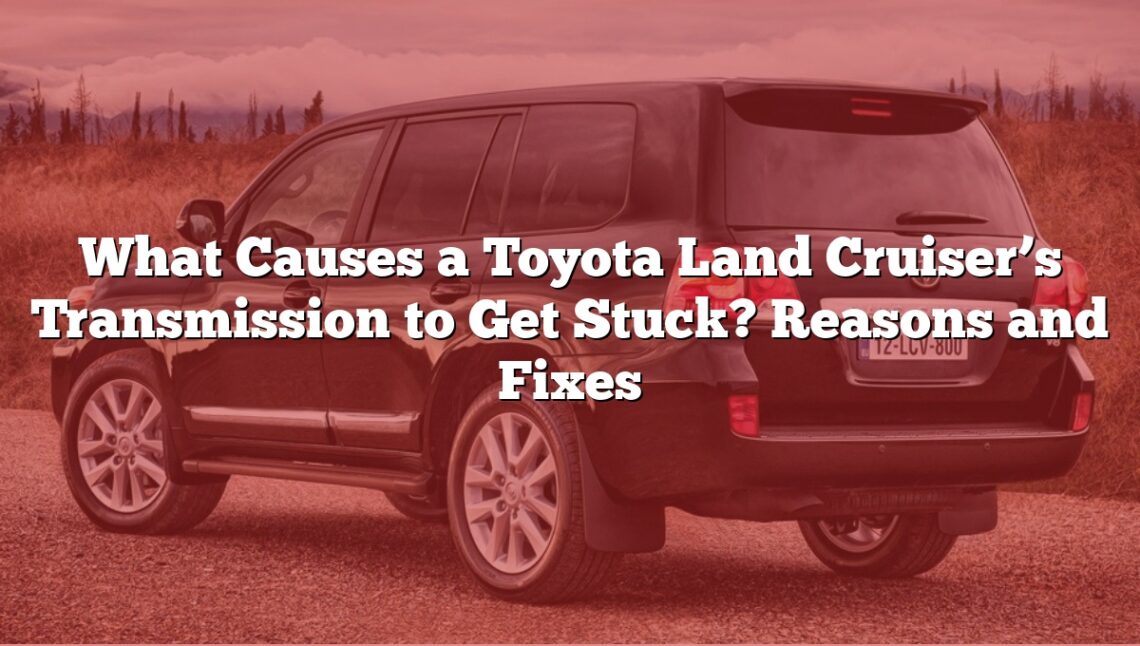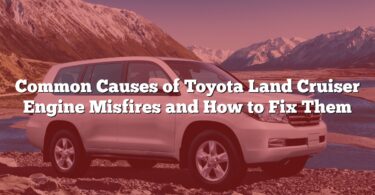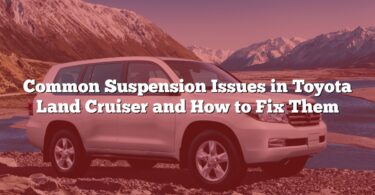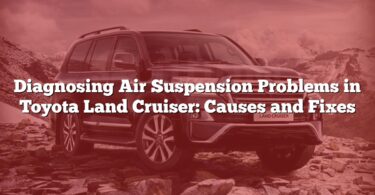A stuck transmission can turn even the most reliable Toyota Land Cruiser into a source of frustration. Understanding the causes behind this issue is key to preventing costly repairs and ensuring smooth operation. In this guide, we’ll explore the common reasons your Land Cruiser’s transmission may fail to shift properly and provide practical fixes to get you back on the road with confidence.
Comprehensive Guide:Problems and Solutions for a Toyota Land Cruiser’s Transmission Issues
| N° | Problem/Cause | Solution |
|---|---|---|
| 1 | Low transmission fluid levels | Check and refill the transmission fluid to the recommended level. |
| 2 | Contaminated or degraded transmission fluid | Flush the system and replace the fluid with the manufacturer-recommended type. |
| 3 | Faulty transmission solenoid | Replace the faulty solenoid. |
| 4 | Malfunctioning shift linkage | Inspect and adjust or replace the shift linkage. |
| 5 | Worn-out clutch components (manual transmission) | Replace the clutch components as needed. |
| 6 | Damaged transmission bands | Inspect and adjust or replace damaged bands. |
| 7 | Worn or damaged gears | Rebuild or replace the affected gears. |
| 8 | Broken or damaged shifter cable | Repair or replace the shifter cable. |
| 9 | Faulty torque converter | Replace the torque converter. |
| 10 | Clogged transmission filter | Replace the transmission filter. |
| 11 | Electronic Control Unit (ECU) failure | Reset, repair, or replace the ECU. |
| 12 | Faulty Transmission Control Module (TCM) | Replace or reprogram the TCM. |
| 13 | Damaged or worn synchronizers (manual transmission) | Replace the damaged synchronizers. |
| 14 | Damaged valve body | Repair or replace the valve body. |
| 15 | Internal transmission damage | Inspect and rebuild or replace the transmission. |
| 16 | Faulty neutral safety switch | Replace the neutral safety switch. |
| 17 | Sensor failure (e.g., speed sensor, position sensor) | Replace the faulty sensor. |
| 18 | Excessive wear on transmission mounts | Replace the worn transmission mounts. |
| 19 | Overheating of the transmission | Check cooling system, fluid levels, and driving habits. |
| 20 | Accumulation of debris or dirt in the transmission | Flush and clean the transmission system. |
| 21 | Software or firmware glitches | Update or reprogram the software/firmware. |
| 22 | Incorrect transmission fluid type used | Flush and replace with the correct fluid type. |
| 23 | Water or moisture contamination | Inspect, flush, and replace contaminated components. |
| 24 | Failure of parking pawl (automatic transmissions) | Replace the parking pawl mechanism. |
| 25 | Damaged or worn bearings | Replace the damaged bearings. |
| 26 | Mechanical interference or obstruction | Inspect and remove the obstruction. |
| 27 | Corroded or damaged wiring connections | Repair or replace damaged wiring and connectors. |
| 28 | Hydraulic pressure issues | Inspect and repair hydraulic components. |
| 29 | Faulty ignition switch | Replace the ignition switch. |
| 30 | Faulty gear selector mechanism | Repair or replace the selector mechanism. |
| 31 | Misaligned transmission components | Realign or adjust the transmission components. |
| 32 | Vacuum leaks (if applicable) | Locate and seal the vacuum leak. |
| 33 | Overloading or towing beyond capacity | Reduce load and avoid exceeding the vehicle’s towing capacity. |
| 34 | Physical damage due to impact or accident | Inspect and repair or replace damaged components. |
| 35 | Lack of regular maintenance | Perform recommended maintenance regularly. |
| 36 | Manufacturing defect | Consult the manufacturer for warranty or recall repairs. |
| 37 | Excessive wear and tear due to age | Replace worn-out transmission components. |
| 38 | Use of aftermarket or incompatible parts | Replace with manufacturer-approved parts. |
| 39 | Shift lock mechanism malfunction | Use the shift lock override or replace the mechanism. |
| 40 | Dirty or contaminated transmission fluid | Perform a fluid flush and replace it with clean fluid. |
| 41 | Failed engine computer (ECU malfunction) | Reset, repair, or replace the ECU. |
| 42 | Broken transmission linkage | Inspect and repair or replace the linkage. |
| 43 | Worn or damaged clutch hydraulics | Repair or replace the hydraulic system components. |
| 44 | Faulty clutch pedal linkage (manual transmission) | Adjust or repair the clutch pedal linkage. |
| 45 | Dragging or slipping clutch (manual transmission) | Replace or adjust the clutch. |
| 46 | Aggressive driving or poor driving habits | Adopt smoother driving habits and avoid harsh shifting. |
| 47 | Unaddressed fluid leaks | Locate and fix the leaks, then refill the fluid. |
| 48 | Faulty or misaligned transmission mounts | Realign or replace the transmission mounts. |
| 49 | Synchro wear (manual transmission) | Replace the worn synchronizers. |
| 50 | Damaged or malfunctioning throttle position sensor | Replace the faulty sensor. |
Detailed Guide: 50 Problems and Solutions for a Toyota Land Cruiser’s Transmission Issues
1. Low Transmission Fluid Levels
Low fluid levels reduce the hydraulic pressure required for proper transmission function. This can cause delayed shifting or prevent the transmission from engaging.
Solution:
- Check the fluid levels using the transmission dipstick.
- Refill with the manufacturer-recommended fluid if the level is low.
- Inspect
the transmission system for leaks, as persistent low levels often indicate a leak. If leaks are detected, repair them promptly before topping off the fluid.
2. Contaminated or Degraded Transmission Fluid
Old or contaminated fluid loses its ability to lubricate and cool the transmission effectively, leading to gear slippage or difficulty shifting.
Solution:
- Drain the old fluid and flush the transmission system.
- Refill with fresh, manufacturer-recommended transmission fluid.
- Replace the transmission filter if necessary.
3. Faulty Transmission Solenoid
The transmission solenoid controls the flow of transmission fluid. A malfunction can cause improper gear shifts or prevent the transmission from engaging.
Solution:
- Use a diagnostic tool to identify the faulty solenoid.
- Replace the solenoid with a new one.
- Test the system to ensure proper operation after replacement.
4. Malfunctioning Shift Linkage
Misaligned or damaged shift linkage prevents the transmission from engaging the correct gear.
Solution:
- Inspect the shift linkage for signs of wear or misalignment.
- Adjust or replace the linkage as needed.
- Lubricate the moving parts for smoother operation.
5. Worn-Out Clutch Components (Manual Transmission)
A worn-out clutch cannot disengage the engine properly, making gear changes difficult.
Solution:
- Replace the clutch disc, pressure plate, or release bearing, depending on the damaged part.
- Inspect the clutch pedal linkage and adjust if necessary.
6. Damaged Transmission Bands
Transmission bands help engage the gears in automatic transmissions. Damaged bands can cause slipping or failure to shift.
Solution:
- Disassemble the transmission and inspect the bands.
- Replace damaged or worn-out bands.
- Adjust the bands according to the manufacturer’s specifications.
7. Worn or Damaged Gears
Worn gears can lead to grinding noises, difficulty shifting, or complete transmission failure.
Solution:
- Disassemble the transmission and inspect the gears.
- Replace damaged or worn gears with OEM parts.
- Reassemble and test the system.
8. Broken or Damaged Shifter Cable
A damaged shifter cable can prevent the gear selector from moving into the desired position.
Solution:
- Inspect the cable for fraying or damage.
- Replace the cable if necessary.
- Adjust the cable tension for accurate gear selection.
9. Faulty Torque Converter
A malfunctioning torque converter can cause shuddering, slipping, or failure to engage the gears.
Solution:
- Remove and inspect the torque converter.
- Replace it with a new or rebuilt unit.
- Flush the transmission fluid to remove contaminants.
10. Clogged Transmission Filter
A clogged filter restricts fluid flow, causing overheating and shifting issues.
Solution:
- Remove the old filter.
- Clean or replace the filter.
- Refill the transmission with fresh fluid.
11. Electronic Control Unit (ECU) Failure
The ECU manages shifting in automatic transmissions. A failure can lead to erratic or no shifting.
Solution:
- Reset the ECU using a diagnostic tool.
- Repair or replace the ECU if resetting does not resolve the issue.
12. Faulty Transmission Control Module (TCM)
A faulty TCM can disrupt gear shifting by misinterpreting signals.
Solution:
- Reprogram or replace the TCM.
- Test the transmission system after repairs.
13. Damaged or Worn Synchronizers (Manual Transmission)
Worn synchronizers prevent smooth engagement of gears, causing grinding noises.
Solution:
- Replace the worn synchronizers.
- Inspect and replace related components if needed.
14. Damaged Valve Body
The valve body directs hydraulic fluid within the transmission. Damage can cause erratic shifting.
Solution:
- Remove and inspect the valve body.
- Repair or replace damaged parts.
- Reinstall and test the system.
15. Internal Transmission Damage
Internal components like bearings or seals may wear out over time.
Solution:
- Disassemble and inspect the transmission.
- Replace damaged components.
- Rebuild or replace the entire transmission if necessary.
16. Faulty Neutral Safety Switch
The neutral safety switch prevents the vehicle from starting in gear. A faulty switch may block shifting.
Solution:
- Test the switch with a multimeter.
- Replace the switch if it fails the test.
17. Sensor Failure (e.g., Speed Sensor, Position Sensor)
Sensors provide critical data for shifting. Failure can disrupt gear changes.
Solution:
- Use a diagnostic tool to identify the faulty sensor.
- Replace the sensor and clear error codes.
18. Excessive Wear on Transmission Mounts
Worn mounts can misalign the transmission, causing shifting issues.
Solution:
- Inspect the mounts for wear or cracks.
- Replace worn mounts and align the transmission.
19. Overheating of the Transmission
Overheating can damage seals and fluid, leading to gear slippage.
Solution:
- Check the cooling system and transmission fluid.
- Install an external transmission cooler if necessary.
20. Accumulation of Debris or Dirt in the Transmission
Debris can block fluid flow and damage components.
Solution:
- Flush the transmission and replace the fluid.
- Clean or replace the filter.
21. Software or Firmware Glitches
Modern transmissions rely on software to manage shifting. Glitches or outdated firmware can cause erratic or incorrect gear changes.
Solution:
- Connect the vehicle to a diagnostic tool.
- Update the transmission software or firmware to the latest version.
- If updating doesn’t solve the issue, reprogram or reset the system.
22. Incorrect Transmission Fluid Type Used
Using the wrong type of transmission fluid can impair lubrication and hydraulic function.
Solution:
- Drain the incorrect fluid completely.
- Flush the system to remove any residue.
- Refill with the manufacturer-recommended transmission fluid.
23. Water or Moisture Contamination
Water in the transmission fluid can cause slippage, overheating, and internal damage.
Solution:
- Inspect the fluid for signs of contamination (e.g., milky appearance).
- Flush the system and replace the fluid.
- Identify and fix the source of moisture ingress, such as a damaged seal.
24. Failure of Parking Pawl (Automatic Transmissions)
The parking pawl prevents movement when the vehicle is in “Park.” Its failure can make shifting impossible.
Solution:
- Inspect the parking pawl for wear or damage.
- Replace the parking pawl if necessary.
- Adjust the linkage mechanism for proper operation.
25. Damaged or Worn Bearings
Damaged bearings can cause grinding noises, vibrations, and shifting difficulties.
Solution:
- Disassemble the transmission to inspect the bearings.
- Replace worn or damaged bearings.
- Lubricate the new bearings properly before reassembly.
26. Mechanical Interference or Obstruction
Foreign objects or damaged parts can obstruct the transmission’s internal components.
Solution:
- Inspect the transmission housing and linkage for obstructions.
- Remove any foreign objects or debris.
- Repair or replace damaged parts causing the interference.
27. Corroded or Damaged Wiring Connections
Electrical faults due to corroded or broken wires can disrupt sensor communication and shifting.
Solution:
- Inspect the wiring harness for signs of corrosion or damage.
- Clean corroded connections and apply dielectric grease.
- Replace damaged wires or connectors as needed.
28. Hydraulic Pressure Issues
Inconsistent or insufficient hydraulic pressure prevents proper gear engagement.
Solution:
- Inspect the hydraulic system for leaks or blockages.
- Repair damaged lines or seals.
- Ensure the fluid level is correct and the pump is functioning properly.
29. Faulty Ignition Switch
A malfunctioning ignition switch can prevent the transmission from shifting out of park.
Solution:
- Test the ignition switch for continuity using a multimeter.
- Replace the switch if it is faulty.
30. Faulty Gear Selector Mechanism
The selector mechanism may wear out or become misaligned, blocking gear selection.
Solution:
- Inspect the gear selector for wear or damage.
- Repair or replace the mechanism.
- Lubricate moving parts to ensure smooth operation.
31. Misaligned Transmission Components
Misaligned components can cause vibrations, noise, and shifting issues.
Solution:
- Realign the transmission components according to the manufacturer’s specifications.
- Check for worn or damaged mounts and replace if necessary.
32. Vacuum Leaks (If Applicable)
Vacuum leaks can affect shifting in some older transmission systems.
Solution:
- Use a vacuum gauge to test for leaks.
- Locate and seal any leaks in the vacuum lines.
- Replace damaged vacuum hoses.
33. Overloading or Towing Beyond Capacity
Excessive loads can strain the transmission, leading to overheating or failure.
Solution:
- Reduce the load to within the vehicle’s towing capacity.
- Allow the transmission to cool before driving further.
- Consider installing a transmission cooler for heavy-duty use.
34. Physical Damage Due to Impact or Accident
Accidents can damage the transmission housing or internal components.
Solution:
- Inspect the transmission for visible damage.
- Repair or replace damaged components.
- Realign the system and test for proper function.
35. Lack of Regular Maintenance
Skipping maintenance can lead to fluid degradation, clogged filters, and wear.
Solution:
- Follow the manufacturer’s recommended maintenance schedule.
- Regularly inspect and replace the fluid and filter.
- Perform periodic checks on the transmission system.
36. Manufacturing Defect
Rare manufacturing defects can cause premature failure of transmission components.
Solution:
- Consult the manufacturer for warranty or recall coverage.
- Replace the defective part with an OEM replacement.
37. Excessive Wear and Tear Due to Age
Age-related wear can lead to leaks, poor performance, and failure.
Solution:
- Replace worn seals, gaskets, and other components.
- Consider rebuilding or replacing the transmission if wear is extensive.
38. Use of Aftermarket or Incompatible Parts
Non-OEM parts may not fit or function properly, causing operational issues.
Solution:
- Replace aftermarket parts with OEM components.
- Verify compatibility before installing new parts.
39. Shift Lock Mechanism Malfunction
The shift lock mechanism may fail, preventing the gear selector from moving out of park.
Solution:
- Use the shift lock override (typically a slot near the shifter) to release the lock temporarily.
- Repair or replace the shift lock mechanism for a permanent solution.
40. Dirty or Contaminated Transmission Fluid
Dirty fluid reduces lubrication and cooling efficiency, leading to shifting issues.
Solution:
- Perform a complete fluid flush.
- Replace the transmission filter.
- Refill with fresh, recommended fluid.
41. Failed Engine Computer (ECU Malfunction)
A faulty ECU can send incorrect signals to the transmission.
Solution:
- Reset the ECU using a diagnostic tool.
- Replace the ECU if the problem persists.
42. Broken Transmission Linkage
A broken linkage disconnects the shifter from the transmission.
Solution:
- Inspect the linkage for breaks or disconnections.
- Repair or replace the damaged linkage.
Preventing Future Issues
To keep your Toyota Land Cruiser’s transmission running smoothly and avoid future problems, follow these preventive measures:
- Regular Fluid Checks and Maintenance
- Inspect the transmission fluid level and condition every 30,000 miles or as recommended by your vehicle’s manual.
- Refill or replace the fluid with the manufacturer-recommended type when necessary.
- Replace the transmission filter during scheduled maintenance.
- Adopt Proper Driving Habits
- Avoid aggressive acceleration and sudden stops to reduce strain on the transmission.
- Shift gears carefully, especially in manual transmissions, to prevent wear on synchronizers and clutch components.
- Allow the vehicle to warm up during cold weather before driving.
- Monitor for Early Warning Signs
- Pay attention to unusual noises, delayed shifting, or fluid leaks.
- If you notice any issues, address them immediately to prevent further damage.
- Avoid Overloading or Excessive Towing
- Stay within the vehicle’s specified weight and towing limits to prevent overheating and undue stress on the transmission.
- Install a transmission cooler if frequent towing is required.
- Ensure Regular Inspections by Professionals
- Have a trusted mechanic inspect your transmission annually or during routine service.
- Request a diagnostic scan to identify potential issues with sensors, solenoids, or the control unit.
- Use Only OEM Parts and Recommended Fluids
- Always choose original equipment manufacturer (OEM) parts and the correct type of transmission fluid.
- Avoid using aftermarket parts that may not meet the manufacturer’s specifications.
- Keep the Cooling System in Good Condition
- Maintain the radiator and transmission cooler to prevent overheating.
- Check for and repair leaks in the cooling system promptly.
- Follow the Manufacturer’s Maintenance Schedule
- Refer to your vehicle’s owner manual for the recommended service intervals.
- Keep a record of all maintenance activities to stay on track with future services.
By following these steps, you can significantly extend the life of your Toyota Land Cruiser’s transmission and ensure reliable performance over time.







